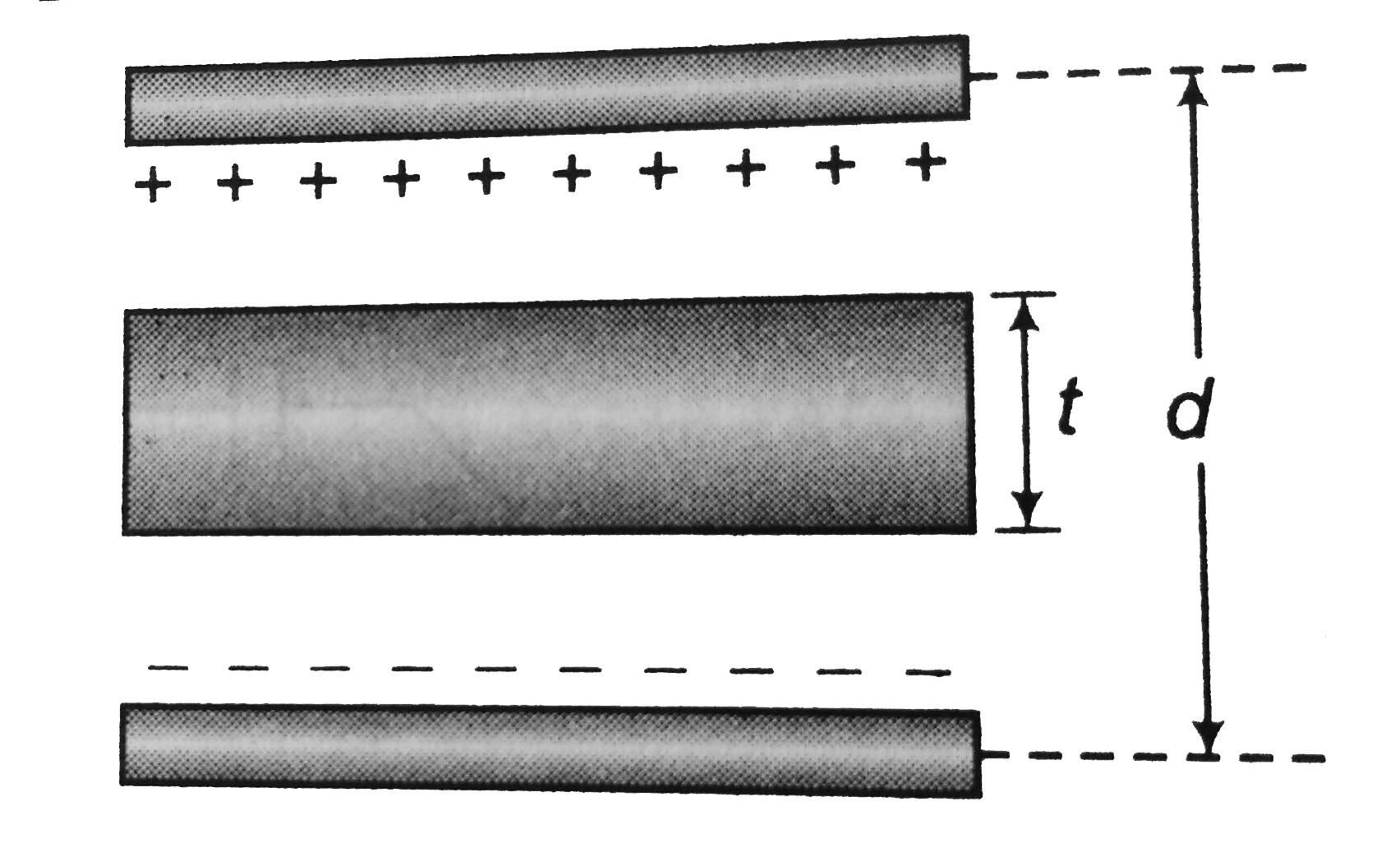In the arrangement shown, the battery is disconnected and a dielectric slab of dielectric constant K is insereted between the plates of capacitor with capacitance C, so as to completely fill the space. What is the final potential differnece across capacitor with capacitance 2C ?
Zero
V
The correct Answer is:3
To solve the problem step by step, we will analyze the situation involving the capacitors and the dielectric slab.
Step 1: Understand the Initial Setup
We have two capacitors in parallel: one with capacitance C and the other with capacitance 2C. Initially, a potential difference V is applied across the combination, and the battery is disconnected.
Step 2: Calculate the Total Capacitance Before Inserting the Dielectric
The total capacitance Ctotal of capacitors in parallel is the sum of their capacitances:
Ctotal=C+2C=3C
Step 3: Calculate the Total Charge Stored
The total charge Q stored in the capacitors when the potential difference V is applied is given by:
Q=Ctotal⋅V=3C⋅V
Step 4: Insert the Dielectric Slab
When a dielectric slab with dielectric constant K is inserted into the capacitor with capacitance C, the capacitance of that capacitor changes. The new capacitance C′ of the capacitor with dielectric becomes:
C′=K⋅C
The capacitance of the other capacitor remains 2C.
Step 5: Calculate the New Total Capacitance
Now, the new total capacitance Cnew of the parallel combination is:
Cnew=C′+2C=K⋅C+2C=C(K+2)
Step 6: Use Charge Conservation to Find the New Potential Difference
Since the battery is disconnected, the charge Q remains constant. The new potential difference V′ across the capacitors can be found using the formula:
V′=QCnew=3C⋅VC(K+2)
Simplifying this gives:
V′=3VK+2
Final Answer
Thus, the final potential difference across the capacitor with capacitance 2C after inserting the dielectric slab is:
V′=3VK+2
We have two capacitors in parallel: one with capacitance C and the other with capacitance 2C. Initially, a potential difference V is applied across the combination, and the battery is disconnected.
The total capacitance Ctotal of capacitors in parallel is the sum of their capacitances:
Ctotal=C+2C=3C
The total charge Q stored in the capacitors when the potential difference V is applied is given by:
Q=Ctotal⋅V=3C⋅V
When a dielectric slab with dielectric constant K is inserted into the capacitor with capacitance C, the capacitance of that capacitor changes. The new capacitance C′ of the capacitor with dielectric becomes:
C′=K⋅C
The capacitance of the other capacitor remains 2C.
Now, the new total capacitance Cnew of the parallel combination is:
Cnew=C′+2C=K⋅C+2C=C(K+2)
Since the battery is disconnected, the charge Q remains constant. The new potential difference V′ across the capacitors can be found using the formula:
V′=QCnew=3C⋅VC(K+2)
Simplifying this gives:
V′=3VK+2
Thus, the final potential difference across the capacitor with capacitance 2C after inserting the dielectric slab is:
V′=3VK+2
Topper's Solved these Questions
- BOOK - AAKASH INSTITUTE ENGLISHCHAPTER - ELECTROSTATIC POTENTIAL AND CAPACITANCE EXERCISE - SECTION-C (OBJECTIVE TYPE QUESTIONS (More than one answer))13videos
ELECTROSTATIC POTENTIAL AND CAPACITANCE
- BOOK - AAKASH INSTITUTE ENGLISHCHAPTER - ELECTROSTATIC POTENTIAL AND CAPACITANCE EXERCISE - SECTION-D(COMPREHENSION-I)2videos
ELECTROSTATIC POTENTIAL AND CAPACITANCE
- BOOK - AAKASH INSTITUTE ENGLISHCHAPTER - ELECTROSTATIC POTENTIAL AND CAPACITANCE EXERCISE - SECTION-B (OBJECTIVE TYPE QUESTIONS (ONLY ONE ANSWER) )1videos
ELECTROSTATIC POTENTIAL AND CAPACITANCE
- BOOK - AAKASH INSTITUTE ENGLISHCHAPTER - ELECTROMAGNETIC WAVESEXERCISE - ASSIGNMENT SECTION - D Assertion-Reason Type Questions25videos
ELECTROMAGNETIC WAVES
- BOOK - AAKASH INSTITUTE ENGLISHCHAPTER - GRAVITATION EXERCISE - ASSIGNMENT SECTION - D (ASSERTION-REASON TYPE QUESTIONS)15videos
GRAVITATION
Similar Questions
A parallel plate capacitor is charged by a battery. After some time the battery is disconnected and a dielectric slab of dielectric constant K is inserted between the plates. How would (i) the capacitance, (ii) the electric field between the plates and (iii) the energy stored in the capacitor, be affected ? Justify your answer.
View SolutionAn air-cored parallel plate capacitor having a capacitance C is charged by connecting it to a battery. Now, it is disconnected from the battery and a dielectric slab of dielectric constant K is inserted between its plates so as to completely fill the space between the plates. Compare :
(I) Initial and final capacitance
(ii) Initial and final charge.
(iii) Initial and final potential difference.
(iv) Initial an final electric field between the plates.
(v) Initial and final energy stored in the capacitor.View SolutionTwo capacitors of capacitance C and nC are connected in parallel. A battery of emf V is connected across the combination. Now the battery is removed and a dielectric constant K is inserted filling the space between the plates of capacitor of capacitance C. The final potential difference across the system is
View SolutionA parallel - plate capacitor of plate area A and plate separation d is charged to a potential difference V and then the battery is disconnected . A slab of dielectric constant K is then inserted between the plate of the capacitor so as to fill the space between the plate .Find the work done on the system in the process of inserting the slab.
View SolutionFigure shows a parallel plate capacitor with plate area A and plate separation d. A potential difference is being applied between the plates. The battery is then disconnected and a dielectric slab of dieletric constant K is placed in between the plates of the capacitor as shown.

The electric field in the gaps between the plates and the electric slab will beView SolutionA parallel plate capacitor of plate area A and plate separation d is charged to potential difference V and then the battery is disconnected. A slab of dielectric constant K is then inserted between the plates of the capacitor so as to fill the space between the plates. If Q, E and W denote respectively, the magnitude of charge on each plate, the electric field between the plates (after the slab is inserted), and work done on the system, in question, in the process of inserting the slab, then
View SolutionAs shown in Fig, a dielectric material of dielectric constant K is insered in half portan between plates of parallel plate capacitor. If its initial capacitance is C, what is the new capacitance ?
 View Solution
View SolutionTwo identical parallel plate capacitors are connected in series to a battery of 100V. A dielectric slab of dielectric constant 4.0 is inserted between the plates of second capacitor. The potential difference across the capacitors will now be respectively
View SolutionA parallel plate capacitor is charged by a battery. After sometime the battery is disconnected and a dielectric slab with its thickness equal to the plate separation is inserted between the plates. How will (i) the capacitance of the capacitor, (ii) potential difference between the plates and (iii) the energy stored in the capacitor be affected ?
Justify your answer in each case.View SolutionA dielectric slab is placed between the plates of a parallel plate capacitor. Its capacitance
A. become zero
B. remains the same
C. decrease
D. increaseView Solution

